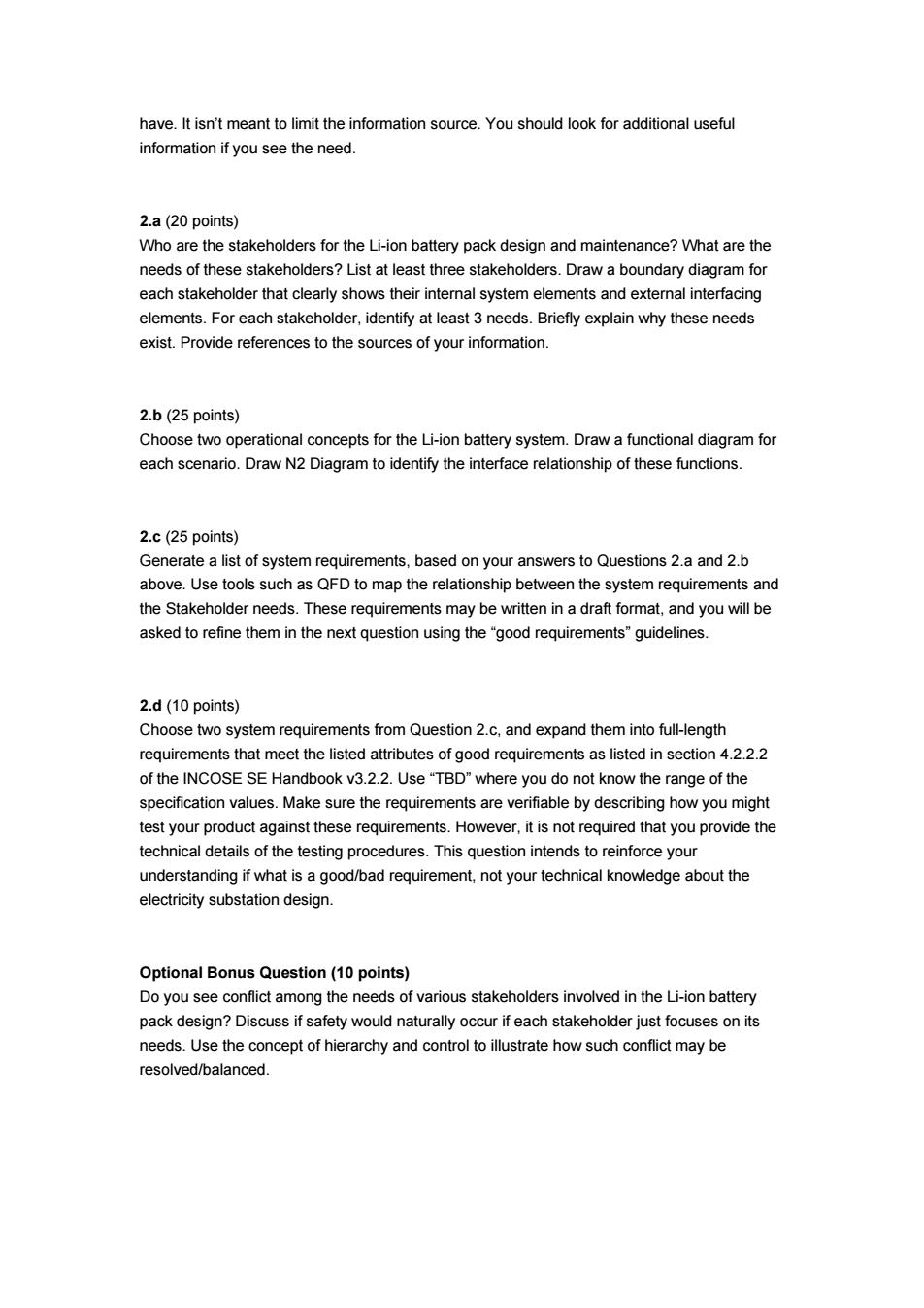正在加载图片...

have.It isn't meant to limit the information source.You should look for additional useful information if you see the need. 2.a(20 points) Who are the stakeholders for the Li-ion battery pack design and maintenance?What are the needs of these stakeholders?List at least three stakeholders.Draw a boundary diagram for each stakeholder that clearly shows their internal system elements and external interfacing elements.For each stakeholder,identify at least 3 needs.Briefly explain why these needs exist.Provide references to the sources of your information. 2.b(25 points) Choose two operational concepts for the Li-ion battery system.Draw a functional diagram for each scenario.Draw N2 Diagram to identify the interface relationship of these functions 2.c(25 points) Generate a list of system requirements,based on your answers to Questions 2.a and 2.b above.Use tools such as QFD to map the relationship between the system requirements and the Stakeholder needs.These requirements may be written in a draft format,and you will be asked to refine them in the next question using the "good requirements"quidelines. 2.d(10 points) Choose two system requirements from Question 2.c,and expand them into full-length requirements that meet the listed attributes of good requirements as listed in section 4.2.2.2 of the INCOSE SE Handbook v3.2.2.Use"TBD"where you do not know the range of the specification values.Make sure the requirements are verifiable by describing how you might test your product against these requirements.However,it is not required that you provide the technical details of the testing procedures.This question intends to reinforce your understanding if what is a good/bad requirement,not your technical knowledge about the electricity substation design. Optional Bonus Question(10 points) Do you see conflict among the needs of various stakeholders involved in the Li-ion battery pack design?Discuss if safety would naturally occur if each stakeholder just focuses on its needs.Use the concept of hierarchy and control to illustrate how such conflict may be resolved/balanced.have. It isn’t meant to limit the information source. You should look for additional useful information if you see the need. 2.a (20 points) Who are the stakeholders for the Li-ion battery pack design and maintenance? What are the needs of these stakeholders? List at least three stakeholders. Draw a boundary diagram for each stakeholder that clearly shows their internal system elements and external interfacing elements. For each stakeholder, identify at least 3 needs. Briefly explain why these needs exist. Provide references to the sources of your information. 2.b (25 points) Choose two operational concepts for the Li-ion battery system. Draw a functional diagram for each scenario. Draw N2 Diagram to identify the interface relationship of these functions. 2.c (25 points) Generate a list of system requirements, based on your answers to Questions 2.a and 2.b above. Use tools such as QFD to map the relationship between the system requirements and the Stakeholder needs. These requirements may be written in a draft format, and you will be asked to refine them in the next question using the “good requirements” guidelines. 2.d (10 points) Choose two system requirements from Question 2.c, and expand them into full-length requirements that meet the listed attributes of good requirements as listed in section 4.2.2.2 of the INCOSE SE Handbook v3.2.2. Use “TBD” where you do not know the range of the specification values. Make sure the requirements are verifiable by describing how you might test your product against these requirements. However, it is not required that you provide the technical details of the testing procedures. This question intends to reinforce your understanding if what is a good/bad requirement, not your technical knowledge about the electricity substation design. Optional Bonus Question (10 points) Do you see conflict among the needs of various stakeholders involved in the Li-ion battery pack design? Discuss if safety would naturally occur if each stakeholder just focuses on its needs. Use the concept of hierarchy and control to illustrate how such conflict may be resolved/balanced